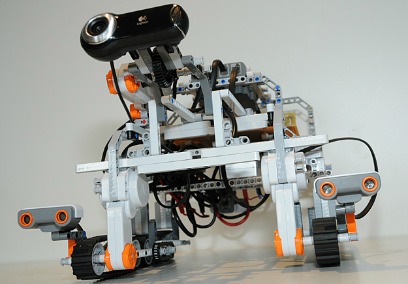Testing the Interplanetary Internet
Astronauts practice communications at Mars by remotely controlling a Lego rover in Germany.

As part of the METERON project, astronauts operated the Mocup test robot in Darmstadt, Germany. Image: ESA
The first humans that head out to Mars might never set foot on the planet. Instead, they could orbit on a Martian space station, where the astronauts remotely command robots working on the planet’s harsh surface. Operating from an orbiting platform — one that’s already set up to support humans, because they flew to Mars inside it — would give the astronauts a wide field of view; they could send robots almost anywhere on the planet and change course as needed, without having to find the kind of safe route that people would require. Indeed, these robots would find it for us.
Astronauts are starting to test these techniques now, except instead of operating robots from low-Mars orbit, they’re driving Lego rovers in Germany from the International Space Station. In late October, then-station commander Sunita Williams opened a laptop and sent the terrestrial toy through a short obstacle course. The tricky part is not the remote operation itself, though it requires some training (no doubt the Mars Curiosity drivers could offer some tips), it’s the infrastructure needed to transmit the signal: the interplanetary Internet.
“The history of space communications is largely what we call point-to-point — we point a big antenna on Earth up at a spacecraft, squirt commands up to it, and we get telemetry back,” explains Adrian Hooke, NASA’s project manager for Space DTN (Disruption Tolerant Networking). He adds that the Mars Curiosity rover is a step ahead of this, using two Mars orbiters as communication relays. “But what we want is a more Internet-like system… of pretty ubiquitous communications, anywhere you want to go.”
You’re reading this blog post thanks to a nearly 40-year-old technology called Internet Protocol (IP). Information travels in packets, hopping from router to router, but if a router has nowhere to send the data because the next router is down, it simply discards those packets.
DTN, however, aims to be a more careful, and thus more reliable system. When mission control on Earth is waiting for a commander’s update from Mars, or when astronauts are carefully constructing our first Martian base from 200 miles up, they don’t want to risk losing any of that data forever if a router burps. So DTN uses Bundle Protocol (BP) — the IP of the interplanetary Internet. Here, when a router receives data packets, it stores them until the next hop becomes available. If the delays are large — due to the vast distances between planets, or because a Mars orbiter is on the far side of the planet — DTN can use a secondary system, called Licklider Transmission Protocol (LTP), which will store the data even if the sender has to go offline before the transmission is complete.
When Williams instructed the Lego rover in Germany to move, the command went from her laptop to the space station’s communications terminal, where a DTN access point began, operated by the University of Colorado. Then it went to NASA’s fleet of tracking and relay satellites, which transmitted the data packets to ground stations in White Sands, New Mexico, then to NASA’s operations center in Huntsville, Alabama, and on to the University of Colorado in Boulder, where they hopped the pond to the European Space Agency’s user support center in Belgium, and finally to ESA’s operations center in Darmstadt, Germany. Then the Lego rover moved. Measurements confirming the movement then traveled the reverse route back to Williams.
“Each one of those was a DTN ‘hop,’” Hooke says. “Sunita steered the robot around some obstacles, and got some very basic data back from the rover…given all those hops, it probably took a couple seconds round trip. She probably saw the response three seconds after she sent the commands.”
For this test, NASA’s DTN team worked with ESA’s METERON project, Multi-purpose End-To-End Robotic Operations Network, which is focused on developing astronaut “telepresence” — operating robots remotely. The ESA hopes that in the coming year or so, astronauts will be tele-operating “Justin,” an android, from the space station.
Eventually, the DTN developed for space could be used by regular folks here on Earth in times of emergency, when communication links are disrupted or jammed, such as during a hurricane or terrorist attack. But NASA’s sights are set far from home. Hooke says interplanetary probes like the Saturn-orbiting Cassini and the upcoming Juno mission to Jupiter, could be repurposed by uploading them with DTN software after their science missions are done. That way, they can serve as Internet nodes throughout the solar system.
“There is nothing inherent in the network that can constrain how far out you can go. It’s more the patience of human beings to wait for a response,” he says.